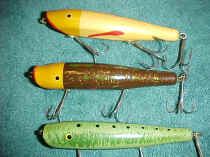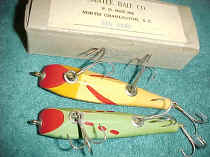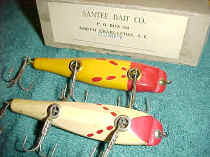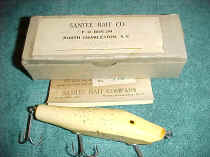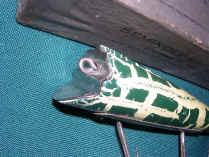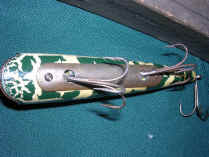Moore's Yellow Plug, Mich. The wooden Moore's Yellow Plug baits made in 1924 by H.C. Moore of Ypsilanti., Mich, have a solid metal head. Moore claimed in the enclosed flyer that his lure "is guaranteed to carry 20 to 30 feet farther than any bait" due to its weight. The box is a hinged, one-piece type. Note the color picture of the Moore's Yellow Plug on boxtop. |
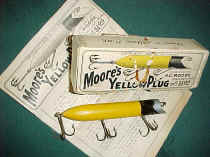 |
Monster Jet Lure, Calif. The wooden Monster Jet Lure is a late 1940s product from Culver Tackle Manufacturers, Pacific Grove, Cal. W.W. Culver was the "owner and inventor." Not only did it have a bizarre (and likely time consuming to manufacture) body shape, but each lure came with a glass bottle of "Natural Fish Oil" guaranteed to make the lure catch fish! . |
|
|
Robinson Bait Co., Orlando, Fla. The Robinson Bait Company Orlando Shiner lures were sold in the late 1930s and into the 1940s as topwater bass plugs. The spotted paint finish is typical of many "Florida style" lures of the era. The Robinson Bait Company boxes are well designed and attractive. The Orlando Shiner is one of the most common Robinson Bait Company lures. |
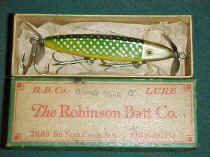 |
Roach's Casting Fly, Vermont These revolving metal lures included ceramic beads and intricate feather hackles. The "Roach" baits were marketed around 1925 by the Roach Bait Company of Montpelier, Vermont. I am not sure what other products this company made, but I suspect the Casting Fly was not their only tackle product. Roach Bait Company made several boxes. |
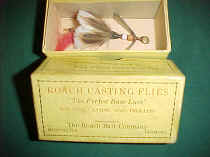 |
Rosenberry ShurLur, Garrett, Indiana The C.E.Z. ShurLur baits were made in the 20s and 30s by the Rosenberry family of Garrett Manufacturing, Indiana. C.E.Z. ShurLur baits are rare. This side-hooked Shur Lur Rosenberry Sucker has milky glass eyes. Rosenberry ShurLur also made an Injured Minnow type bait. Garrett Manufacturing and ShurLur are the same firm. |
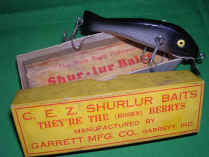 |
Rosenberry's Baits, Garret, Ind. This is the earliest Rosenberry Shurlur bait with the "patent applied for" box and Garrett Bait Company name. Rosenberry Shur Lure Baits and Garrett Bait Company were thought to be related to Creek Chub. Rosenberry lures almost always have tiny cup hardware on the hook hangers. The pink cello in this box is original to the lure. |
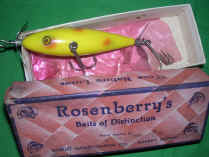 |
Santee Bait Co., N. Charleston, S.C. These elegantly painted wooden lures were made by an unknown inventor from North Charleston for use in Santee-Cooper lakes, impounded in 1939. The Dolly Jumper, with its wonderful carved, upturned lip, is believed to be this company's first lure. Note the folky paint jobs. Other lures included the Gumpy, Snoopy and Santee Special. |
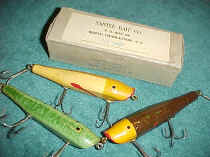 |
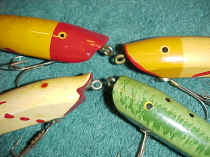 |
|
|
Santee Bait Company lures have, in the past, been mis-identified as products of Florida makers such as Costa, Porter, Florida Fishing Tackle and Earl Gresh, but this set of boxed Santee Bait Company lures helps separate fact from conjecture. The Gumpy lures have concave bellies, much like Florida Fishing Tackle Co.'s Old Albert lures. The Santee Special, made like a Dalton Special or Creek Chub Darter, sometimes has its name in script on the tail. The Snoopy bait shown here is the only such specimen known. Remember that the Santee-Cooper lakes, widely renowned as an early bass fishing venue, were bisected by U.S. 301 - the primary thoroughfare for Florida-bound anglers prior to the advent of Interstate highways. The relevance of the connection between these lures and their famous Florida counterparts cannot be underestimated. I wish we knew more about their maker. Santee Bait Company lures are very collectible. |
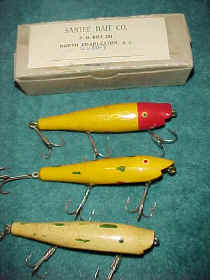 |
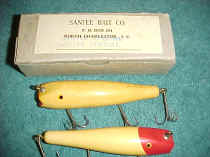 |
|
Schaller Three-Bagger, Mendota, Ill. The 'Three-Bagger" is an odd chunk bait from the early 1930s made by E.W. Schaller of Mendota, Ill., and sold for $1.50 - a tidy sum for the era. The huge instruction pamphlet includes verbage that would make any snake-oil salesman proud, but the lure is well-made and elaborate, with a special unique machined, removable primary hooking device. |
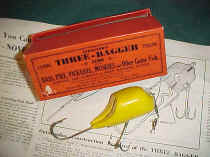 |
A.F. Schnell, Kankakee, Illinois The "Fish-Getter" baits made by August Frederick Schnell in the late 1920s are somewhat less appealing than the wonderful boxes this Illinois lure was sold in. The nickel-plated body is equipped with a unique weedless hook and a spinner similar to Al. Foss products of the same era. Schell was a tool and die maker, and a teacher. |
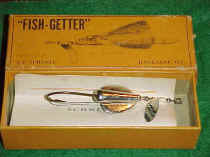 |
|
Scooter Pooper, Columbia, S.C. The Scooterpooper, or Scooter Pooper, is an oddball bait made from little tin boxes that once contained watch parts. The tins were sealed shut and soldered to a shaft. Invented in Greenwood, S.C., these 1940s lures were sold in Columbia. Many Scooterpooper lures are still on active duty today, and still catching fish. |
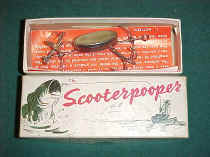 |
|
Schoonie's Skooter, Michigan John R. Schoonmaker of Kalamazoo patented this side-to-side wobbling Schoonies Skooter bait in 1916. It had vanished a few years later. The lure has offset grooves to make the bait zig and zag. Schoonie's Scooter boxes are rare and usually turn up only in Michigan, where this one was found. Note the two different paper flyers. |
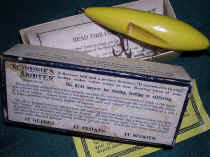 |
Schoonie's Skooter Junior This is the much-rarer Schoonies Skooter Junior lure, also circa 1916. The slogan is interesting: "The Bait that Thinks Itself a Fish!" Note the rainbow paint pattern - nearly identical to that of another famous Kalamazoo company - William Shaksepeare. To my knowledge, this is the ONLY Schoonie's Scooter Junior box known. |
|
Seminole Bait, Baltimore, Maryland The Seminole Bait is a work of art with a machined head plate, a metal belly strip into which hooks are attached and grooves down the back. Boxes have been found saying they were made in Towson or Baltimore, Maryland. They are thought to be connected to the Garvin Brothers of Eustis, Florida, who operated Florida Lure Manufacturing Company. The Seminole Bait dates to the 1920s or early 30s. |
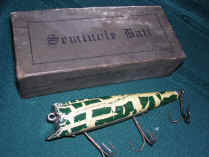 |
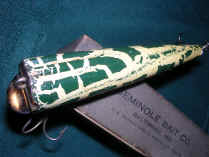 |
|
Here is an earlier Seminole Bait Company lure with a slide-out box. The label says Towson, Maryland, instead of the later Baltimore box above. Both boxes carry the perplexing "U.S. Patent Office Serial Number 623410" which we have been unable to decipher. This black and white lure has a pointed, nickel-plated belly plate, while the Seminole Bait above has a rounded German silver plate. |
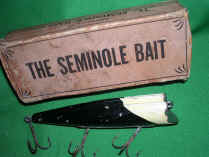 |
|
Shoff's Casting Mouse This is one of the larger versions of the popular deer hair mice sold throughout the 20s, 30s, 40s and 50s. Dating to the 1930s, the Shoff's Casting Mouse featured bead eyes, a leather tail and lots of hair. With a weight, this lure could be cast as a lure, not simply as a flyrod bait. |
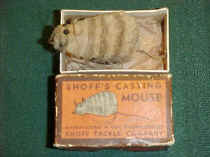 |
Shoff Bass Wagtail This Bass Wagtail by the same maker as above - the Shoff Tackle Co. of Kent, Washington - comes in a huge yellow box. This bait dates to the 1930s and likely could have been designed as a salmon lure, due to its size. It would be quite buoyant and would perform in moving water. |
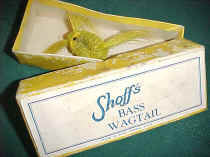 |
Shooting Lure, Detroit, Michigan The mechanical, spring-loaded Shooting Lure was made in the mid 1940s by machinist Thomas G. Prentice. This is the patent model with a metal shaft with slots into which a pin was inserted to hold it in the cocked position. When a fish struck, the pin was dislodged, and the lure "fired," shooting the hook into the fish's mouth. This Shooting Lure is a patriotic red, white and blue! It is mint in a rare Shooting Lure picture box, with paper flyer inside. |
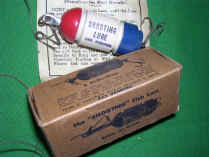 |
Shooting Lure, Detroit, Michigan The mechanical, spring-loaded Shooting Lure was made in the mid 1940s by machinist Thomas G. Prentice. This is the patent model with a metal shaft with slots into which a pin was inserted to hold it in the cocked position. When a fish struck, the pin was dislodged, and the lure "fired," shooting the hook into the fish's mouth. This Shooting Lure is a patriotic red, white and blue! It is mint in a rare Shooting Lure picture box, with paper flyer inside. |
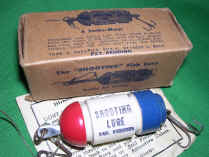 |
